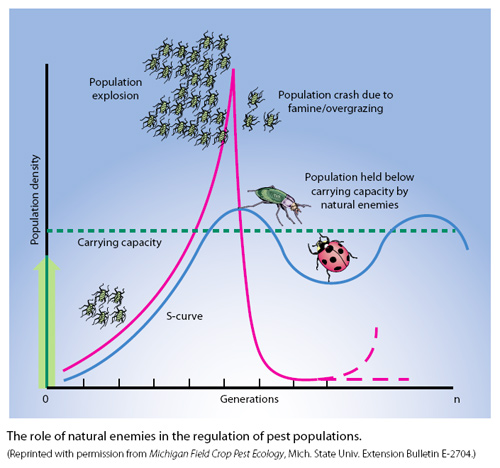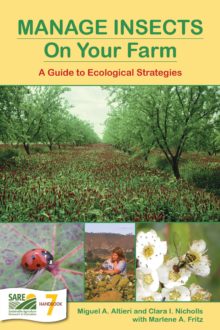
Predators
Predators occur in most orders of insects but primarily in the beetle, dragon-fly, lacewing, wasp and true bug families (Coleoptera, Odonata, Neuroptera, Hemiptera and Diptera, respectively). Their impacts have been highlighted worldwide by eruptions of spider mite pests where chemical insecticides have eliminated the mites’ predators. Tetranychid mites, for example, are usually very abundant in apple orchards where pesticides have destroyed natural predator populations.
The diversity of predator species in agroecosystems can be impressive. Researchers have reported more than 600 species — from 45 families — of predaceous arthropods in Arkansas cotton fields and about 1,000 species in Florida soybean fields. Such diversity can apply major regulatory pressures on pests. Indeed, many entomologists consider native, or indigenous, predators a sort of balance wheel in the “pest-natural enemy complex” because they tend to feed on whatever pest is over-abundant. Even where predators can’t force pest populations below economically damaging levels, they can and do slow down the rate at which potential pests increase. In spray-free apple orchards in Canada, five species of predaceous true bugs were responsible for 44 to 68 percent of the mortality of codling moth eggs.
Biodiverse farms are rich in predatory insects, spiders and mites. These beneficial arthropods prey on other insects and spider mites and are critical to natural biological control (Table 3). They can feed on any or all stages of their prey, destroying or disabling eggs, larvae, nymphs, pupae or adults. Some predators — like lady beetles and ground beetles — use chewing mouthparts to grind up and bolt down their prey. Others — like assassin bugs, lacewing larvae and syrphid fly larvae — have piercing mouthparts; they often inject powerful toxins into their prey, quickly immobilizing them before sucking their juices.
Many predatory arthropods — including lady beetles, lacewing larvae and mites — are agile and ferocious hunters. They actively stalk their prey on the ground or in vegetation. Other hunters — such as dragonflies and robber flies — catch their prey in flight. In contrast, ambushers patiently sit and wait for mobile prey; praying mantids, for example, are usually well camouflaged and use the element of surprise to nab their unsuspecting victims.
Most predators are “generalist” feeders, attacking a wide variety of insect species and life stages. They may have preferences — lady beetles and lacewings, for instance, favor aphids — but most will attack many other prey that are smaller than themselves. Some important predator species are cannibalistic; green lacewings and praying mantids are notorious for preying on younger and weaker members of their own species. The diet of most predators also includes other beneficial insects, with larger predators frequently making meals of smaller predators and parasites.
As a rule, predators are predaceous regardless of their age and gender and consume pollen, nectar and other food as well as their prey. However, some species are predaceous only as larvae; as adults, they feed innocently on nectar and honeydew or aid and abet the predatory behavior of their young by laying their eggs among the prey. Lacewings are predaceous only during their immature stages. Other species are lifelong predators but change targets as they mature.
